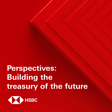Introduction to HSBC Talks Business
00:00:00
Speaker
Welcome to HSBC Talks Business, the podcast series that brings together business leaders and industry experts to explore the latest global insights, trends, and opportunities.
00:00:11
Speaker
Make sure you're subscribed to stay up to date with new episodes.
00:00:14
Speaker
Thanks for listening.
00:00:15
Speaker
And now onto today's show.
Role of Materials in Energy Transition
00:00:23
Speaker
Welcome to our latest Transition Pathways podcast episode.
00:00:28
Speaker
My name's Zoe Knight and I lead our climate change efforts in the Middle East, but I'm also a commissioner with the Energy Transitions Commission.
00:00:36
Speaker
Today, we're going to talk about the role of materials and minerals in the energy transition.
00:00:42
Speaker
We know that the transition to net zero will require a significant expansion of the production and supply chains for copper, lithium, nickel and many other resources.
Demand for New Mines by 2030
00:00:51
Speaker
And in fact, according to a new report from the Energy Transitions Commission,
00:00:56
Speaker
as many as 250 new mines might be needed to meet demand for clean energy materials by 2030.
00:01:02
Speaker
And that's a staggering figure.
00:01:05
Speaker
So where is all this investment going to come from?
00:01:08
Speaker
Which supply chains are most at risk from a shortage of key materials?
00:01:12
Speaker
And how is the materials sector taking action to expand production?
Importance of Materials Beyond Batteries
00:01:16
Speaker
So to answer those questions, I'm delighted that I'm joined today by Leonardo Guitza, lead supply chains and materials analyst at the Energy Transitions Commission.
00:01:26
Speaker
Sophie Liu, HSBC's Global Head of Heavy Industry Decarbonisation, and Michael Willoughby, Global Head of Metals, Mining and Transition Materials at HSBC.
00:01:37
Speaker
So first off, Leonardo, as the lead author of the ETC's Material and Resources Report, perhaps we can start by clarifying the role of materials and resources in the energy transition.
Categorizing Energy Materials
00:01:48
Speaker
I'm sure many listeners will be thinking straight away of the metals that are needed for batteries, but it goes much deeper than that.
00:01:55
Speaker
What do we mean when we talk about materials for the transition?
00:01:59
Speaker
The energy transition is cross-sectoral major transition from the current fossil fuel-based energy system to a new clean energy system that's going to evolve over the coming decades.
00:02:11
Speaker
And that's going to require the rapid, vast deployment across a wide range of different clean energy technologies, whether it's solar and wind in the power sector,
00:02:23
Speaker
or electrolysers to produce green hydrogen or batteries, as you said, for electric vehicles and stationary storage.
00:02:32
Speaker
Each one of those technologies needs materials to get built.
00:02:35
Speaker
So as we deploy all of these clean energy technologies to drive the energy transition, that's going to drive increased demand for a wide range of different materials.
00:02:45
Speaker
And when we talk about these energy transition materials, I think it's helpful to think of them really in two big buckets.
00:02:53
Speaker
One bucket is these
Resource Availability Myths
00:02:55
Speaker
industrial materials that are kind of cross-cutting across almost every single clean energy technology and of course a very wide range of other sectors.
00:03:04
Speaker
And really the three classic examples here are steel, aluminium and copper.
00:03:09
Speaker
You'll find them in every single clean energy technology, but also in most products that we come across in our big data.
00:03:16
Speaker
The other big bucket is really materials that are specific to individual clean energy technologies and where the deployment of these technologies is going to drive a big increase in demand.
00:03:27
Speaker
So there we might be talking about polysilicon to go in solar panels or lithium, cobalt, nickel that go in batteries.
00:03:36
Speaker
or rare earth elements that end up both in electric vehicle motors or in wind turbines.
00:03:41
Speaker
And so for those materials, firstly, the energy transition is going to be more of a driver of demand in coming decades.
00:03:48
Speaker
But secondly, they tend to be a bit more specific to individual technologies.
00:03:53
Speaker
And maybe the final point I'd make is that we know that the energy transition is going to drive this big increase in demand for many materials.
00:04:02
Speaker
But it's important to keep in mind the wider context.
00:04:05
Speaker
Often we get some pushback that this big increase in demand for materials puts into doubt the wider sustainability of the energy transition.
00:04:13
Speaker
But really, this shift to a clean energy system is a shift to an inherently more sustainable
00:04:19
Speaker
lower emissions system that is going to have much lower impact on the world and the environment around us and is also going to mitigate emissions significantly and lead to a pathway where we manage to stabilize temperatures by the middle of this century.
00:04:35
Speaker
So that's a really great introduction to what we're talking about.
Supply Bottlenecks in Copper and Lithium
00:04:41
Speaker
Now the ETC makes it quite clear in the report that there is enough raw materials to meet the goals
00:04:48
Speaker
that we need to deliver in terms of transitioning away from fossil fuels.
00:04:52
Speaker
But there is a warning in some sectors that we may be heading for a supply squeeze.
00:04:57
Speaker
Where are the bottlenecks today and potentially in the future?
00:05:02
Speaker
In our report, I mean, we really wanted to achieve two things.
00:05:05
Speaker
So first off, we wanted to maybe bust some of these myths around materials and their availability, and specifically here bust the myth that there aren't enough materials out there to meet future demand.
00:05:17
Speaker
So this is something that's quite well understood to say within the mining metals industry.
00:05:22
Speaker
and among experts, but in wider conversations, this kind of narrative is often used to sometimes push back against the energy transition and accelerated climate action.
00:05:32
Speaker
And this simply isn't true.
00:05:33
Speaker
So, you know, to be very clear, we've got more than enough lithium, copper and the rest of it to meet future demand in coming decades, to be a little
00:05:44
Speaker
one land, more than plentiful to meet demand through to 2050.
00:05:48
Speaker
And that's demand both from the energy transition, but also from all these other non-energy related sectors.
00:05:55
Speaker
We have more than enough materials.
00:05:57
Speaker
But as you said, the key challenge is scaling up annual supply, annual production quickly enough to meet rapidly growing demand.
00:06:06
Speaker
And a large amount of the analysis in our report was focused on this particular topic.
00:06:11
Speaker
So we tried to look at where demand might be to 2030 and what do current analysts currently expect supply to end up at by 2030 as well.
00:06:22
Speaker
And really, the picture varies depending on the type of material that you look at.
00:06:27
Speaker
I'd say that each material has its own story.
COVID Impact on Mineral Supply Chains
00:06:30
Speaker
For some materials, say, cobalt or nickel, although you might expect demand to increase quite rapidly, the price incentives tend to work quite well for these materials.
00:06:42
Speaker
And so, A, there's expectations for significant increases in supply for these materials.
00:06:47
Speaker
but also innovation, efficiency and the rest of it to sometimes substitute or pivot demand away from these materials also plays out quite well.
00:06:56
Speaker
So there's quite strong potential, but even though right now it might look like supply and demand in coming years might be mismatched, that those gaps should close in coming years.
00:07:07
Speaker
But there were two materials that when we went through and carried out our analysis really stood out in terms of potential concern in coming years.
00:07:15
Speaker
They are copper and lithium.
00:07:18
Speaker
And for both of these, the picture is a little bit more challenging.
00:07:21
Speaker
So for lithium, where the key element really to electric vehicles and their batteries, we're expecting to see a very rapid increase in demand driven by rapid EV uptake in China, Europe, and now the US as well.
00:07:35
Speaker
And at least at the moment, there's not loads of options to substitute away that material demand.
Western Mining Challenges
00:07:42
Speaker
And then the other one is copper.
00:07:43
Speaker
Copper is really interesting.
00:07:45
Speaker
It's often talked about as the material of electrification.
00:07:48
Speaker
Demand is really cross-cutting across lots of different technologies.
00:07:53
Speaker
And so even though you can substitute it, say to aluminium in some wiring and cabling and so on, because this demand is so widespread, it's difficult to achieve very large scale demand reductions or substitutions.
00:08:09
Speaker
Sophie, I'd like to bring you in at this point.
00:08:12
Speaker
And I know that you've been studying the findings from this report as well.
00:08:16
Speaker
Does it match your own experience in who you're talking to and which industries today are already facing these supply constraints?
00:08:25
Speaker
In my sort of experience in the industry in the last few years, there were some disruptions to various critical mineral supply chains caused by COVID.
00:08:35
Speaker
But most of those sort of pandemic related supply chain issues have kind of worked their way through.
00:08:40
Speaker
The bigger impact that the pandemic had on the supply chain stability is really more the pipeline of new exploration projects and the development of new resources.
00:08:51
Speaker
There was a significant amount of disruption related to both the ability to finance and invest them, as well as the physical operation and the discovery that was occurring.
00:09:00
Speaker
So I think there's a bit of a misperception in the industry of there not being enough critical minerals, as Leonardo already described.
00:09:07
Speaker
There really is enough, but there's a difference between reserves and resources.
00:09:12
Speaker
Reserves are what the industry assesses to be technically and economically feasible to produce.
00:09:18
Speaker
And that is a moving target that changes over time depending on how many new deposits are explored,
00:09:24
Speaker
how many new innovations occur in exploration and extraction technologies that help to reduce the cost of production, as well as, quite frankly, the permitting sophistication of a lot of markets that have the resource but not the experience and the industry to extract it in a sustainable manner.
00:09:44
Speaker
There's been a lot of discussion of a desire to try to expand critical minerals extraction and production in markets like the US and Europe, which are driven by issues around supply chain security, right?
00:09:56
Speaker
And not necessarily supply chain deficits, but supply chain security.
00:09:59
Speaker
But part of the barriers, the ability to develop more economically and technically extractable reserves in markets like the U.S. is that there's not been for many years now a strong and robust tradition of mining of minerals in those
Overcoming Mining Challenges with Partnerships
00:10:16
Speaker
So it means that the regulatory environment for it is not particularly friendly when it comes to permitting.
00:10:22
Speaker
And there lacks a degree of sophistication amongst investors in those markets to be able to read and understand what types of reserves are worth investing into and not.
00:10:32
Speaker
So for all of the more mature mining markets like Canada and Australia,
00:10:37
Speaker
For mining companies that are listed on the Toronto Stock Exchange or the Australian Stock Exchange, they're all required to disclose their technically feasible produced reserves in what we call JORC, kind of a reserve disclosure standard that is used in the investment industry.
00:10:56
Speaker
But standardized JORC disclosures are not required for mining.
00:11:00
Speaker
critical minerals producers or who are potentially looking at it, who are listed in the US, for instance.
00:11:06
Speaker
And I think a lot of US investor bases are not necessarily used to reading and understanding what a JORC assessment means or the viability of a project.
00:11:14
Speaker
So I would say that there's a lot of other issues related to the supply chain.
00:11:18
Speaker
That's not necessarily just because there isn't enough in the world, but it's a lot more just the technical competency.
00:11:26
Speaker
Now, Michael, you're close to the companies that are producing many of these materials in your day-to-day activities, right?
00:11:32
Speaker
So what are they doing to head off these potential supply shortages?
00:11:37
Speaker
And are there any examples that you can share from your conversations across the industry?
Industrial Sector's Net-Zero Priorities
00:11:43
Speaker
So, look, I guess it's easy to kind of conclude our companies should react to this and fill the perceived supply gap.
00:11:51
Speaker
But as we know, companies are just a collection of their shareholders and the markets where the shareholders are based and the capital that's formed to fund them.
00:12:00
Speaker
And if we take a step back and look at what
00:12:04
Speaker
mining means to the broader economy.
00:12:06
Speaker
I mean, we had a massive China boom 2008, 9, 10, 11, and then a massive bust.
00:12:14
Speaker
Too much capacity was built and it meant that returns for the mining community in the West were very, very low for a number of years.
00:12:21
Speaker
And in certain senses, we're still in that position and Western markets certainly perceive
00:12:28
Speaker
that we're in that position.
00:12:29
Speaker
So, you know, less than 1% of the S&P 500 in the US is mining related.
00:12:34
Speaker
It's a little bit more than that on the FTSE and quite a bit more on the ASX, but generalists with a lot of liquidity aren't putting mining at the top of their lists.
00:12:43
Speaker
You know, the other aspect is that you've had government subsidies from non-Western markets for a long period of time.
00:12:49
Speaker
And so their share of production has gone up, which when that supply goes up, you have Western listed companies that aren't as incentivized to invest in new production.
00:12:59
Speaker
So recently things have changed a little bit.
00:13:01
Speaker
You've seen Western governments start to offer subsidies to start to incentivise Western mining companies to look at greenfield developments, which are very, very rare, believe it or not, for Western mining companies.
00:13:13
Speaker
But because you've had a lot of investment over the last decade from particularly China, the Chinese companies lead the processing technology, which really is the big constraint on the supply coming out.
00:13:26
Speaker
There's enough resources
00:13:27
Speaker
subject to permitting and other things.
00:13:29
Speaker
But unless you've got the processing technology and particularly ESG friendly processing technology, you know, resources themselves don't actually matter a whole lot.
00:13:39
Speaker
You've then got the labour issue.
00:13:41
Speaker
I mean, you've got this huge deficit in skilled labour in mining and particularly mining engineers that know how to design and build a greenfield mine.
00:13:53
Speaker
If you're a Western mining company and you've got a choice to buy back your own stock or invest in a new greenfield mine, you're going to buy back your own stock at three or four times cash flow.
00:14:02
Speaker
And unfortunately, that's just a fact.
00:14:05
Speaker
So what's the answer here?
00:14:08
Speaker
The answer here is to partner with low costs of capital and higher appetite for risk, which is generally sources like Saudi sovereign wealth funds, Korean battery companies, Japanese trading companies, Chinese tech companies, governments.
00:14:24
Speaker
So they're the sources of capital as opposed to Western countries.
00:14:28
Speaker
equity markets and then the sources of supply are going to be wherever suppliers argentina for lithium indonesia for nickel drc for cobalt and those partnerships between those various countries and companies will
ETC's Recommendations for Mining Supply
00:14:44
Speaker
de-risk projects both in terms of political nature technology nature and and diversity of supply
00:14:52
Speaker
Yeah, I mean, it's super interesting to see the way that the trading partners and the company linkages are springing up all over the world.
00:15:03
Speaker
And, you know, this also tallies with some of the findings of some work that HSBC did recently.
00:15:09
Speaker
We surveyed over 350 companies globally in the industrials and resources sector because we wanted to really understand what the sentiment is towards transition from those companies.
00:15:20
Speaker
And also just to say, I'm sure many of you listening to this will already know that the ESG acronym stands for Environmental, Social and Governance.
00:15:28
Speaker
But it's clearly become a topic that many investors are thinking about.
00:15:34
Speaker
Many companies want to drive harder on and want to understand how they fit into that story.
00:15:40
Speaker
For our survey, what we really did was looked at everything from metals and mining to chemicals and plastics.
00:15:46
Speaker
And we broke down the results into various subsectores.
00:15:50
Speaker
Now, bearing in mind this is about sentiment, it was asking questions around how many companies would look more closely at net zero transition and what was holding them back.
00:16:01
Speaker
But some of the key findings are that 96% of discovery and extraction businesses say that the net zero transition is one of their top three priorities, and 59% said that it's their top priority.
00:16:15
Speaker
There's no real disputing that companies are thinking about how to manage these new drivers that are being faced and also unlock the opportunities.
00:16:26
Speaker
So in the minerals and non-ferrous metal segment, companies were particularly likely to see the transition as an opportunity to grow their business.
00:16:34
Speaker
New business streams and new geographical markets ranked as the biggest opportunities in the transition.
00:16:39
Speaker
So there's a real appetite to grow with it within this space.
00:16:45
Speaker
I think now we'll just look at a little bit more at the decarbonisation levers and talk about how this is going to pan out in practice.
00:16:53
Speaker
And I think the ETC has worked pretty hard on trying to make reports practical so that we can really get into the detail of helping companies to transition and figure out the problems that we need to solve so as to be able to move this agenda faster.
00:17:08
Speaker
So, Leo, what are the practical steps that the ETC recommends on this topic?
00:17:15
Speaker
So I guess when we looked at this big issue of materials for the energy transition, there were three big cross-cutting challenges that we identified that have already come up in conversation.
00:17:28
Speaker
So one is scaling up primary mine supply.
00:17:32
Speaker
And so we need to build new mines and expand the supply.
00:17:35
Speaker
The second is diversifying the current system of both mined
00:17:41
Speaker
and especially refined process to supply these materials to reduce some of the risks from the high level of concentration.
00:17:48
Speaker
And the third is addressing some of these environmental, social and governance impacts.
00:17:53
Speaker
I'll just add a little bit of detail on each of those.
00:17:57
Speaker
In terms of building new mines, we mentioned at the start the figure of potentially needing up to a few hundred of new mines across all these different energy transition materials, copper, nickel, cobalt, lithium and so on in the coming decades.
00:18:12
Speaker
Now, obviously this needs increased investment, but it's not just the new investments, it's also faster planning and permitting, as Sophie mentioned,
00:18:22
Speaker
some of the enabling infrastructure, especially in geographies that maybe are less well developed, but also crucially, as Michael mentioned as well, making sure that there's the right pipeline of skills and available engineers and the rest of it for these companies as they expand in coming years.
Profitability Challenges in Mining
00:18:42
Speaker
On the second issue of diversification, and here it's obviously become quite a politically salient topic, the interplay between critical mineral supply and wider energy security.
00:18:54
Speaker
So the current supply of materials is very concentrated, especially at the refining stage, whether it's for the rare earth elements, copper,
00:19:03
Speaker
graphite and so on, much of the refining processing, well over 50% takes place in China.
00:19:08
Speaker
And that high level of concentration has some associated risks really, not just because of potential trade or geopolitical tensions, but also really more just to do with potential exhaustion shocks, whether it's drought or pandemics, as we found a few years ago, knocking out supply from a particular region.
00:19:28
Speaker
both companies and potentially governments should be seeing some level of diversification as really just a risk management strategy in coming years.
00:19:38
Speaker
It's not going to happen overnight.
00:19:40
Speaker
Thirdly, that big bucket of environmental, social impacts
00:19:45
Speaker
And here, I mean, we don't just want to address these because they are inherently good in and of themselves.
00:19:52
Speaker
It's a good thing to reduce climate emissions.
00:19:55
Speaker
It's a good thing to minimize biodiversity impacts on the rest of it.
00:19:58
Speaker
But also, at least at the Energy Transition Commission, we really feel that in order to keep the wider societal buy-in for the energy transition, we have to make sure that this build-out of clean energy technologies
00:20:11
Speaker
and the associated material requirements is done as sustainably as possible.
00:20:15
Speaker
And so this means, for example, decarbonizing production of the big industrial materials like steel and aluminium.
00:20:23
Speaker
It also might mean, you know, focusing on how to ensure that local communities experience as many of the benefits and as few of the local environmental impacts that mining projects tend to come in.
00:20:35
Speaker
Finally, just to end on a slightly more optimistic note, I think there's a very big role to play in coming years for both technology and materials efficiency and also recycling to try and alleviate pressure on primary supply.
00:20:49
Speaker
Really, the action that innovation, efficiency and recycling can take in the coming decades helps to address all these three big cross-cutting challenges.
00:21:00
Speaker
And so that might look like continuous innovation in the battery market.
00:21:05
Speaker
We've already seen that in the last few years with a big shift away from cobalt rich batteries towards nickel rich batteries.
00:21:13
Speaker
or it means potentially a little bit more targeted support to incentivize a bit more research and innovation in other industries to reduce the total material requirements, help them shift to low impact material substitutes and the rest of it.
00:21:28
Speaker
And on the recycling front, I mean, here really the big story is the potential for recycling of batteries at end of life.
00:21:34
Speaker
By the mid 2030s, we're going to start seeing
00:21:37
Speaker
hundreds of millions of electric vehicles start to reach end of life, the EVs that are currently being sold right now, and making sure we have in place the right infrastructure, logistics and recycling capacity to make the most of those EVs at end of life and make sure that there's significant secondary supply of some of these crucial materials can help ease some of the potential supply demand gaps in the coming decade or so.
00:22:07
Speaker
So there's both the new product plus the recycling side that companies can think about.
00:22:13
Speaker
So back to you, Michael, when it comes to production, you touched slightly on what's going to make a profitable mine going forward.
00:22:22
Speaker
But is it really just a question about cost, profitability, or are there other issues as well as the labour point that you touched on earlier?
Innovation in Mining Technologies
00:22:32
Speaker
Well, any Western-listed company, it is about –
00:22:36
Speaker
profitability and certainty, you know, they're the two elements that create investment.
00:22:41
Speaker
And for mining, because you're usually selling to a floating price, pricing certainty is the one thing that you don't have.
00:22:50
Speaker
And that's why it doesn't attract as much capital as, let's say, infrastructure, which in many cases is very similar.
00:22:58
Speaker
You know, it's a very large plant with big capital commitments and long-term
00:23:03
Speaker
uh economics the difference is that floating commodity price risk and that's why the cost of capital is far higher in in mining you mentioned before esg is you know one of the top three business decision drivers uh for corporates you know that that's absolutely right and you know if you look at scale and scaling up in an existing mining project
00:23:27
Speaker
the one impediment to that often is ESG concerns and challenges.
00:23:32
Speaker
I mean, by scaling up, you're talking about a lot more disturbance of the natural environment.
00:23:38
Speaker
You're talking about a lot more water usage, power usage, labor content, infrastructure requirements.
00:23:45
Speaker
It is not just as simple as scaling up.
00:23:49
Speaker
And it's even harder in a greenfield sense
00:23:53
Speaker
You know, so recycling comes on in 10 or 15 years and greenfield mines take 10 or 15 years to build and come to production.
00:24:00
Speaker
So we are stuck with what we can see in front of us in terms of production, which means that we are going to have shortages in many commodities for the next 10 years until the price goes up to incentivise added supply coming on and more investment going in.
00:24:17
Speaker
The only way to solve that is through maximising efficiency of the ecosystem.
00:24:23
Speaker
And that's, you know, using each country and company's unique strengths and pulling them together in JVs where they can have the maximum efficiency.
00:24:34
Speaker
And that's mining, technology, capital, geography and government relations.
00:24:41
Speaker
And that's naturally happening in some points and in others there's a lot of resistance against that.
00:24:48
Speaker
Yeah, it's an area that we're just going to have to keep on working through, I suppose,
00:24:53
Speaker
I mean, going back to the transition pathway survey and thinking about the heavy industrial space, Sophie, what more can we think about in terms of that side of the equation?
00:25:05
Speaker
I think Mike is absolutely correct to highlight the need for system efficiency and using what we already have in global supply chains.
00:25:13
Speaker
But our survey also has some really interesting kind of statistics that came out.
00:25:17
Speaker
So of the many heavy industrials that we surveyed, 54 percent of them expect to spend more of their CAPEX on net zero transition solutions in the next two to three years.
00:25:28
Speaker
And while some of the sort of net zero transition solutions that we have to decarbonize metals and mining and other heavy industrial products might cost slightly more, a lot of the companies, the industrials that are adopting these solutions are also expecting to be able to earn more.
00:25:42
Speaker
Because at the end of the day, it's not about who is the lowest cost, it's about who is the highest margin, right?
00:25:47
Speaker
So we found that 56% of the steel producers that we surveyed expected to be able to earn a green premium for their products.
00:25:53
Speaker
which meant that, yes, they might spend more to produce a cleaner and more ESG-oriented product, but they expect to be rewarded for such.
00:26:00
Speaker
I would also add with a final note, which is in addition to all of these other sort of things that we've considered, in the critical mineral space, there's a massive amount of room for innovation and new development of technology.
00:26:11
Speaker
I think people sort of think of mining as a traditional sector.
00:26:14
Speaker
There's not a lot to disrupt, but actually there's a huge amount that could potentially impact its ability to produce at much bigger scale than it currently does.
Investments Needed for Energy Transition Materials
00:26:23
Speaker
but in a more ESG and sustainable friendly manner.
00:26:26
Speaker
So there's new mechanisms for waste tailings disposal, like dry stacking and things where you could essentially reduce some of the issues related to that.
00:26:35
Speaker
There are innovations occurring in ore beneficiation, including bio ore beneficiation that would reduce the amount of energy that's needed in order to improve the quality of the materials that are going to processing.
00:26:49
Speaker
And then there are other even more cutting edge things like, for instance, you can actually farm nickel.
00:26:53
Speaker
So in certain areas, particularly that have been land that's been depleted or heavily soiled with heavy metals from previous mining exercises, you can actually plant certain types of plants that will extract the metal.
00:27:05
Speaker
and then the process those plants and you can process those plants into two streams of one biomass materials for energy production as well as refined nickel for critical minerals production so i think that um we do need to think about it from an innovative perspective and that more research and rd should be going into the critical mineral space in addition to the market efficiencies and the improvements to regulations and infrastructure thanks sophie so
00:27:33
Speaker
You know, we've really honed in on the idea that attractive returns are just going to be an investment driver.
00:27:40
Speaker
And that's going to be an important part of mobilising the funding needed for this.
00:27:45
Speaker
But as we've touched on, we know that that's also a challenge for the international community and places.
00:27:52
Speaker
So there are plenty of investors chasing the renewable energy assets.
00:27:57
Speaker
to be developed, but it is harder to connect the impact focused idea and the impact focused investors with new mining projects.
00:28:06
Speaker
So, Leo, the ETC has identified a figure of 70 billion needed each year through 2030 to expand production.
00:28:16
Speaker
How close are we to meeting that?
00:28:19
Speaker
Yeah, as Michael mentioned before, in the early 2000s, we saw this big commodity super cycle, mainly driven by massive China boom that lasted through to around 2012 or 2013.
00:28:31
Speaker
And investments in both capex, but also exploration really fell off a cliff after 2012, 2013.
00:28:40
Speaker
And so since then, over the last decade or so, mining capital investments, excluding gold and iron, they've averaged around $40 to $50 billion each year.
00:28:51
Speaker
And if we look at the biggest energy transition materials, we reckon that around $70 billion needs to be invested each year through the 2030s, maybe the mid 2030s, in order to expand production at the pace that is needed by the energy transition.
00:29:10
Speaker
And so achieving that is going to be the big challenge of the coming decade.
00:29:15
Speaker
But so far, it's around 45 to 50 billion a year, right, versus that 70 that we're looking to find.
00:29:22
Speaker
So, Michael, in your experience, is there anything being done to close this funding gap in terms of incentivisation?
00:29:30
Speaker
there's quite a lot of things that are disparate, but all working together.
00:29:35
Speaker
I mean, as a system kind of works together, you know, it gets more efficient over time.
00:29:39
Speaker
And, you know, some of those examples are, I mean, just the international finance community, we all started looking at carbon abatement and everything became about carbon abatement.
00:29:52
Speaker
That needed to be done.
00:29:53
Speaker
And that's been very successful.
00:29:55
Speaker
You know, the next step to that is the financial community development.
00:30:00
Speaker
incentivising and facilitating transition by lending money at lower rates of return to areas that are going to have a meaningful impact, particularly on technology, which can be scaled as opposed to individual sites, which are not necessarily scaled.
00:30:18
Speaker
And that's generally happening as the broader community and the broader financial community understand some of the complex issues
00:30:26
Speaker
more deeply you know secondly there's specific areas where governments are starting to price capital uh carbon in so you know in aluminium into the eu area for example you know there is a basically a tax on
00:30:42
Speaker
on heavy carbon emissions in aluminium.
00:30:45
Speaker
And so if you're clean, low carbon emissions aluminium, then you don't have that tax and that equalises the price going into the EU.
00:30:52
Speaker
And that will then be replicated in other metals over time.
00:30:57
Speaker
And they're the sort of incentives that we need.
00:31:00
Speaker
I think the other thing that we should all be cognisant of is a lot of the consumer companies and the auto companies, they are critical
00:31:09
Speaker
to paying the green premium for steel for example and the green premium for other
00:31:16
Speaker
So the consumer needs to put pressure on those consumer brands to represent them and put pressure on therefore their supply chains to make sure the carbon footprint is lower, the ESG content is checked.
00:31:32
Speaker
And that also then, dare I say, it comes back to partnerships where you've got to maximize the efficiency of the whole ecosystem together.
00:31:42
Speaker
On top of that, you've also got the government policies now starting to be rolled out wholesale across Western markets.
00:31:50
Speaker
At the end of the day, the quickest way to transition is to incentivize private investment.
00:31:56
Speaker
And that's the one thing that's really been lacking outside of maybe lithium,
00:32:01
Speaker
for Western capital markets, which are the biggest in the world.
00:32:04
Speaker
So solving that last piece of the puzzle will then very quickly facilitate solving a lot of the other pieces of the puzzle that we're talking about here.
00:32:14
Speaker
Yeah, it's a really important observation that incentivisation of private companies to really get involved in this space.
00:32:24
Speaker
We're going to be drawing to a close quite soon, but
00:32:28
Speaker
Sophie, is there anything else that companies can be doing as a business as usual activity to get this transition moving?
00:32:37
Speaker
Well, I think they need to be making decarbonisation and ESG performance as a BAU, if it's not already for anybody that's in the space.
00:32:44
Speaker
The mandate to operate for this entire critical mineral space is its ability to outperform the conventional energy systems.
00:32:51
Speaker
in its ability to contribute to climate transition and
Conclusion and Call to Action
00:32:55
Speaker
So this is the one thing we need to get right in order to be able to be the main supplier of critical materials for the future.
00:33:02
Speaker
Maybe one of the things we need to kind of keep in mind, decarbonization is important.
00:33:07
Speaker
All the other aspects of ESG and critical materials is important, but we need to look
00:33:13
Speaker
at it from a perspective of engagement.
00:33:16
Speaker
So there are efforts to isolate and create islands of ESG performance in the supply chain.
00:33:29
Speaker
And this is not helpful.
00:33:30
Speaker
So I think the one takeaway would be that as we're all making ESG and the end to carbonization as a BAU in our performance, we need to continue to think about the fact that we need to be engaging the whole global supply chain in order to achieve that end goal.
00:33:45
Speaker
And that just coordinating off our own little tiny bit of clean supply chains is not the most effective path forward.
00:33:53
Speaker
And that really links to the ecosystem points that we made earlier and the partnership approach.
00:34:00
Speaker
Well, we've covered a lot of ground today on the supply chain of critical materials.
00:34:05
Speaker
It's just left for me to say, Leonardo, congratulations once again on this report.
00:34:10
Speaker
It's another piece of fantastic work and analysis from the partnerships that the ETC have in place.
00:34:18
Speaker
And I'm sure that we'll be referring to these findings for a long time to come.
00:34:22
Speaker
Thank you also to my colleagues, Michael and Sophie at HSBC for sharing their thoughts and to you all for taking the time to listen to this podcast.
00:34:33
Speaker
For more insights on today's conversation, do visit our Transition Pathways website and the Centre of Sustainable Finance via the episode description.
00:34:43
Speaker
Thank you for joining us at HSBC Talks Business.
00:34:47
Speaker
We hope you enjoyed the discussion.
00:34:48
Speaker
Please do subscribe to the HSBC Talks Business channel to stay up to date with new episodes.


















